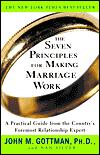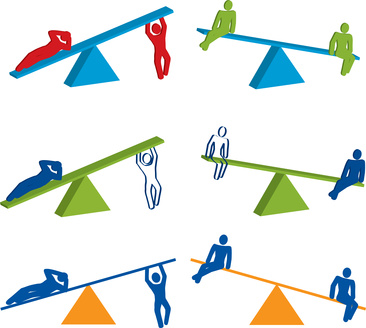John Gottman, PhD, revolutionized the study of marriage with his  Seattle “Love Lab,” an apartment designed with one-way mirrors, cameras, and sensors for heart rate, pulse, and other stress markers. Couples volunteered to spend time in the “Love Lab” to interact with one another, argue with one another, and even resolve arguments under the eyes of scientific observers. After years of research, Dr. Gottman was able to accurately predict the success or failure of a marriage observed in the “Love Lab” 91% of the time. Dr. Gottman found four key predictors of success or failure in marriage. One, how the couple initiates conversations, especially disagreements, predicts marital success or failure. If they begin with a harsh start up, it generally ends badly. Second, if a couple uses the “four horsemen” during their discussion, the interactions goes from bad to worse. The “four horsemen” include criticism, contempt, defensiveness, and stonewalling. When these “four horsemen” run wild during an interaction, the relationship will get trampled under a stampede. Third, if one partner consistently feels overwhelmed by the negativity of their spouse and emotionally disengages from the relationship to protect themselves, the relationship falters. Fourth, if the couple is unable to repair their emotional connection during and after a disagreement, they damage their relationship and create an unhappy future for themselves. If a couple experiences each of these difficulties on a consistent basis, they create bad memories, a negative history that distorts our perception of our partner. So, what is a couple to do? How can a couple prevent these factors from entering into and destroying their marriage? Read the rest of this book to find out! You will discover ways to develop, sustain, and revive the friendship inherent in a successful marriage. Chapters three through eleven reveal 7 principles that create marital success. Dr. Gottman discusses everything from “enhancing your love map” to “allowing your partner to influence you” to “solving problems.” Each chapter ends with several practical exercises to help couples master the skill of each principle and enhance their relationship. After all, marriages are not strengthened and saved by avoiding the markers of divorce, but by building a healthy friendship and connection between marital partners. This book will give every couple the tools necessary to build their friendship, enhance their intimacy, and enjoy a truly successful marriage.
Seattle “Love Lab,” an apartment designed with one-way mirrors, cameras, and sensors for heart rate, pulse, and other stress markers. Couples volunteered to spend time in the “Love Lab” to interact with one another, argue with one another, and even resolve arguments under the eyes of scientific observers. After years of research, Dr. Gottman was able to accurately predict the success or failure of a marriage observed in the “Love Lab” 91% of the time. Dr. Gottman found four key predictors of success or failure in marriage. One, how the couple initiates conversations, especially disagreements, predicts marital success or failure. If they begin with a harsh start up, it generally ends badly. Second, if a couple uses the “four horsemen” during their discussion, the interactions goes from bad to worse. The “four horsemen” include criticism, contempt, defensiveness, and stonewalling. When these “four horsemen” run wild during an interaction, the relationship will get trampled under a stampede. Third, if one partner consistently feels overwhelmed by the negativity of their spouse and emotionally disengages from the relationship to protect themselves, the relationship falters. Fourth, if the couple is unable to repair their emotional connection during and after a disagreement, they damage their relationship and create an unhappy future for themselves. If a couple experiences each of these difficulties on a consistent basis, they create bad memories, a negative history that distorts our perception of our partner. So, what is a couple to do? How can a couple prevent these factors from entering into and destroying their marriage? Read the rest of this book to find out! You will discover ways to develop, sustain, and revive the friendship inherent in a successful marriage. Chapters three through eleven reveal 7 principles that create marital success. Dr. Gottman discusses everything from “enhancing your love map” to “allowing your partner to influence you” to “solving problems.” Each chapter ends with several practical exercises to help couples master the skill of each principle and enhance their relationship. After all, marriages are not strengthened and saved by avoiding the markers of divorce, but by building a healthy friendship and connection between marital partners. This book will give every couple the tools necessary to build their friendship, enhance their intimacy, and enjoy a truly successful marriage.
Archive for October 27, 2012
Take Off Your Family Mask For Halloween
 Slip.” I know, a little geeky…but I liked his costume. My other favorite costume is one that looks like a person riding a horse or broom. I encouraged my daughter to dress up with two of her friends, all in black, so they could kneel next to each other and be an ellipsis. Alright, I know, a little strange. But what would Halloween be if not a little strange? Those are silly Halloween costumes we might wear once a year but we may wear more serious masks around our family all year round. Seriously, have you ever hidden behind a “mask” around your loved ones? Have you hidden your true self behind a façade in the presence of your family? I have. Unfortunately, hiding our true self behind a mask will eventually cause serious problems in your family. So, as you prepare to take off your Halloween mask, consider taking off these masks as well?
Slip.” I know, a little geeky…but I liked his costume. My other favorite costume is one that looks like a person riding a horse or broom. I encouraged my daughter to dress up with two of her friends, all in black, so they could kneel next to each other and be an ellipsis. Alright, I know, a little strange. But what would Halloween be if not a little strange? Those are silly Halloween costumes we might wear once a year but we may wear more serious masks around our family all year round. Seriously, have you ever hidden behind a “mask” around your loved ones? Have you hidden your true self behind a façade in the presence of your family? I have. Unfortunately, hiding our true self behind a mask will eventually cause serious problems in your family. So, as you prepare to take off your Halloween mask, consider taking off these masks as well?· The Everything’s-Fine Mask. This mask is especially insidious between spouses. From the outside the person
 looks and acts like everything is fine. On the inside, however, they are seething with anger, overwhelmed with sorrow, frustrated by lack of cooperation, irritated with the lack of help, or boiling over with any number of other emotions. The Everything’s Fine Mask hides the person’s true feelings and robs the family of any opportunity to change and grow more intimate. The person behind the mask eventually feels taken advantage of and may become resentful…or even blow up in anger. Yes, the Everything’s-Fine Mask is a time bomb waiting to explode. Take this mask off by speaking the truth in love. Be vulnerable. Remove the mask and reveal your true feelings. Lovingly let your family know what bothers you. Then, stick around for an honest and loving discussion that can lead to the resolution of any frustration and anger that lurks behind the mask. You will discover that your family truly does love you and is more than willing to work with you in banishing the Everything’s-Fine Mask!
looks and acts like everything is fine. On the inside, however, they are seething with anger, overwhelmed with sorrow, frustrated by lack of cooperation, irritated with the lack of help, or boiling over with any number of other emotions. The Everything’s Fine Mask hides the person’s true feelings and robs the family of any opportunity to change and grow more intimate. The person behind the mask eventually feels taken advantage of and may become resentful…or even blow up in anger. Yes, the Everything’s-Fine Mask is a time bomb waiting to explode. Take this mask off by speaking the truth in love. Be vulnerable. Remove the mask and reveal your true feelings. Lovingly let your family know what bothers you. Then, stick around for an honest and loving discussion that can lead to the resolution of any frustration and anger that lurks behind the mask. You will discover that your family truly does love you and is more than willing to work with you in banishing the Everything’s-Fine Mask!· The It’s-All-Your-Fault Mask. You know this mask when you hear those infamous words, “It’s not my fault. I wouldn’t have done that if you hadn’t….” The person wearing the It’s-All-Your-Fault Mask casts blame on everyone but themselves. They refuse to take responsibility for any misbehavior, hurtful words, or wrong choices. This mask is humbling to remove. It involves accepting responsibility for one’s own actions. Removing the mask may mean becoming humble enough to apologize for hurtful words or rude actions. Removing this mask and humbly accepting personal responsibility is also empowering. It means accepting power over one’s choices and growing in integrity. As we become known as a person of integrity, relationships improve and grow more intimate. So, take a risk. Humbly remove the It’s-All-Your-Fault Mask and accept responsibility for your actions…starting in your family.
· The Nobody-Loves-Me Mask. The Nobody-Loves-Me Mask sneaks up on us at the worst times. You’ve seen it. The person wearing this mask begins to mope around and look dejected. When asked, they simply reply, “Nobody loves me.” After further questioning you may discover that this person feels unloved because of an unintentionally hurtful
 statement. No one else knew that the statement bothered them. Rather than put on the Everything’s-Fine Mask, they put on the Nobody-Loves-Me Mask. They withdraw and sulk, silently waiting for other family members to notice them, chase them, and express undying love for them. Not realizing why this person is sulking, the family leaves them alone. The person wearing the mask takes this to mean—you guessed it, “Nobody loves me.” The best way to remove this mask is through communication. Do not expect the rest of your family to read your mind. Simply express your need for clarification on the hurtful statement. Express your desire for some affirmation or loving attention. In other words, quit sulking, take off the mask, and interact with your family. You will soon discover how much they truly do love you and want to involve you in the family activities.
statement. No one else knew that the statement bothered them. Rather than put on the Everything’s-Fine Mask, they put on the Nobody-Loves-Me Mask. They withdraw and sulk, silently waiting for other family members to notice them, chase them, and express undying love for them. Not realizing why this person is sulking, the family leaves them alone. The person wearing the mask takes this to mean—you guessed it, “Nobody loves me.” The best way to remove this mask is through communication. Do not expect the rest of your family to read your mind. Simply express your need for clarification on the hurtful statement. Express your desire for some affirmation or loving attention. In other words, quit sulking, take off the mask, and interact with your family. You will soon discover how much they truly do love you and want to involve you in the family activities.Increase Family Happiness in 5 Minutes a Day!
 can help you prepare for this special day. This activity will also bring increased happiness, greater life satisfaction and more positive emotions into your home. Everyone who participates will reap the benefits. Best of all, it is simple. It takes only about five minutes a day and a specific interaction twice a week. So, spending about an hour and a half each week in this activity can increase your family’s joy, happiness, and life satisfaction. Sound too good to be true? Only one way to find out—give it a try. Here’s what you do.
can help you prepare for this special day. This activity will also bring increased happiness, greater life satisfaction and more positive emotions into your home. Everyone who participates will reap the benefits. Best of all, it is simple. It takes only about five minutes a day and a specific interaction twice a week. So, spending about an hour and a half each week in this activity can increase your family’s joy, happiness, and life satisfaction. Sound too good to be true? Only one way to find out—give it a try. Here’s what you do. and have everyone do it with one other family member for the second time each week. You could share during dinner or a special desert. You might decide to share first thing in the morning or as you prepare for bed. However or whenever you choose, share something from your gratitude list with the rest of your family two times a week.
and have everyone do it with one other family member for the second time each week. You could share during dinner or a special desert. You might decide to share first thing in the morning or as you prepare for bed. However or whenever you choose, share something from your gratitude list with the rest of your family two times a week. Teach Your Child the Art of Waiting
 had no control. He was all over the place—climbing the walls (literally) and touching everything. The neurologist walked in to see my exasperation. Then he performed a miracle. He produced a small wind-up toy from his pocket, wound it up, set it on the bed, and walked out of the room. The toy took three small steps, banged small cymbals, and did a flip…over and over again. The 6-year-old stopped running around and watched the toy. When it stopped performing, he wound it up and started over. Throughout the process, he stayed calm. He began to learn the art of waiting. And I began to learn my role in helping children learn to wait. Since then, I have learned several lessons to help children wait. Here are five tips to help your child learn the art of waiting…and keep you from pulling your hair out at the same time.
had no control. He was all over the place—climbing the walls (literally) and touching everything. The neurologist walked in to see my exasperation. Then he performed a miracle. He produced a small wind-up toy from his pocket, wound it up, set it on the bed, and walked out of the room. The toy took three small steps, banged small cymbals, and did a flip…over and over again. The 6-year-old stopped running around and watched the toy. When it stopped performing, he wound it up and started over. Throughout the process, he stayed calm. He began to learn the art of waiting. And I began to learn my role in helping children learn to wait. Since then, I have learned several lessons to help children wait. Here are five tips to help your child learn the art of waiting…and keep you from pulling your hair out at the same time. · Plan ahead. Pack a small bag with toys, books, games, and even a small snack to engage your child while waiting. Let him bring his favorite book or project to an appointment where he may have to wait. Enjoy a small snack while waiting. Play a game of cards, build with Lego’s, or play with a handheld game. You can even plan something special immediately following the appointment that demands waiting, such as a trip to the ice cream store or a special meal at home.
· Don’t rush ’em, let ’em finish. During your daily life, allow your child to focus on his activities without the stress of having to quit early. In doing so,
 you recognize how much your child values that activity. He feels understood and appreciated. And, with that understanding firmly in place, he will become more willing to wait when necessary. Sometimes you will not have the time to allow your child to finish his project before you have to move on to the “next thing.” When that is the case, give a warning. Let him know he only has 20 more minutes to finish what he can and clean up. Help him determine a good spot to stop for the day. Warn him again at 10 minutes and then at 5 minutes let him know it is time to clean up.
you recognize how much your child values that activity. He feels understood and appreciated. And, with that understanding firmly in place, he will become more willing to wait when necessary. Sometimes you will not have the time to allow your child to finish his project before you have to move on to the “next thing.” When that is the case, give a warning. Let him know he only has 20 more minutes to finish what he can and clean up. Help him determine a good spot to stop for the day. Warn him again at 10 minutes and then at 5 minutes let him know it is time to clean up. · Show your child that you are reliable. When you say you will do something, do it. When you make a promise, keep it. A recent study showed that children who experience reliable interactions with an adult are better able to wait. The 3-to 5-year-olds in this study delayed gratification four times longer after experiencing a reliable adult who kept their promise. So, keep your promises. Show your child that you are reliable. When your child knows you as reliable, your word and your promise will help them practice the art of waiting.
· Model the art of waiting for your children. Children learn from watching. They mimic their parents. They repeat the patterns of behavior they see in their parents. So, if you want your children to practice the art of waiting, let them see you waiting patiently as well.
How Grace-full Is Your Family

· Other families crush grace. They believe that a good set of rules to live by will make everything turn out right…and they use a hammer to enforce those rules. Relationships are neglected and made secondary to rules. Personal image becomes defined by my ability to obey the rules. Family members become arrogant as they comply with the rules or overwhelmed with shame when they fall short. The whole family may adopt a “holier-than-thou” attitude as they present the perfect family, structure in place, and outward behavior complying with that structure. When someone breaks a rule, shame-based, guilt inducing discipline helps bring them back into line. Fear-based discipline motivates them to avoid punishment. Unfortunately, family members often become resentful of this, feel inadequate, and may eventually rebel against those rules.
· Today we see many families who manipulate grace. They believe that simple love and acceptance will produce self-control and character. They also hate to see people suffer. So, relationships remain strong but very few, if any, rules are put in place. This family has strong relationships with little to no structure. They give no consequence for misbehavior. Many times, family members will even bail the misbehaving person out of the consequence. Some
 family members will even suffer for the lazy or misbehaving person. For instance, the parent who stays up late to complete their child’s project while the child watches TV or goes to bed. In grace-manipulating families, people learn that anger is stronger than love and comfort more important than character. Unfortunately, the family becomes enslaved to the one who is most willing to manipulate grace.
family members will even suffer for the lazy or misbehaving person. For instance, the parent who stays up late to complete their child’s project while the child watches TV or goes to bed. In grace-manipulating families, people learn that anger is stronger than love and comfort more important than character. Unfortunately, the family becomes enslaved to the one who is most willing to manipulate grace.· Healthy families strive to become grace receivers. Grace receiving families nurture healthy, loving relationships while providing a clear, consistent structure to promote positive behavior. They see misbehavior as an opportunity to grow more mature. Discipline provides the opportunity to learn more appropriate behavior and, in the long run, promote deeper intimacy within the family. Family members find acceptance even when they miss the mark and suffer the consequences of inappropriate behavior. With unconditional acceptance and loving relationships supporting a consistent structure, family members learn from their mistakes, gain wisdom, and grow more self-controlled.
My Mom Kept That…Art?
My daughter took a pottery class in 6th grade. You can see the beautiful pottery 
 she made in her class in the picture to the left. Her grandmother (my mother) visited us soon after she finished the class. While visiting, she noticed and admired the pottery my daughter had made. While encouraging my daughter’s talent, she mentioned the pottery “her father” (that’s me) made in 6th grade. I had a faint recollection of that artistic endeavor. In my mind I had made a pitcher. It was round and had a small opening on the top that gracefully lipped outward. The round body had a face sculpted into one side and the ears formed handles on each side of the face. It was an odd color though…kind of a muddy brown. A few months later, we visited grandma’s house and she presented my 6th grade pottery for my daughter’s admiration. My daughter, obviously stunned and speechless, stared at my work of art before a somewhat quizzical smile began to grow across her face. I took my work in my hands and looked at it from all sides. Not quite what I remembered. It was…well, what can I say? Ugly-it was ugly. I mean, it was the ugliest thing I had ever seen. It had no face, no ears, no…beauty. (You can see I am not exaggerating by looking at the picture to the right.) Obviously, my daughter did not get her artistic abilities from me.
she made in her class in the picture to the left. Her grandmother (my mother) visited us soon after she finished the class. While visiting, she noticed and admired the pottery my daughter had made. While encouraging my daughter’s talent, she mentioned the pottery “her father” (that’s me) made in 6th grade. I had a faint recollection of that artistic endeavor. In my mind I had made a pitcher. It was round and had a small opening on the top that gracefully lipped outward. The round body had a face sculpted into one side and the ears formed handles on each side of the face. It was an odd color though…kind of a muddy brown. A few months later, we visited grandma’s house and she presented my 6th grade pottery for my daughter’s admiration. My daughter, obviously stunned and speechless, stared at my work of art before a somewhat quizzical smile began to grow across her face. I took my work in my hands and looked at it from all sides. Not quite what I remembered. It was…well, what can I say? Ugly-it was ugly. I mean, it was the ugliest thing I had ever seen. It had no face, no ears, no…beauty. (You can see I am not exaggerating by looking at the picture to the right.) Obviously, my daughter did not get her artistic abilities from me. 

You know what I found amazing though? Twenty-seven years before my daughter constructed her pottery, I brought home that incredibly “unique” piece of work. But, my mother never ridiculed my work; she never demeaned my effort. Instead, she accepted it, imperfect as it was. She knew that my developmental ability limited what I could do…and she accepted me and my effort anyway. She also knew that my lack of artistic talent limited what I could accomplish…and, she accepted me and my effort anyway. She knew that my “work of art” fell far short of perfect. It definitely missed the mark; but she accepted me and my effort anyway. She showed the extent of her acceptance by keeping my pottery over the span of 27 years. In fact, she packed it up when the family moved from Pittsburgh to Houston. She kept it when I left for college and kept it when the family moved from Houston to San Antonio to Eagle Pass to Austin and, finally, to Lock Haven. Twenty seven years later, and six cities later, she knew where it was and produced it, still safe and sound, for my daughter to see. When she unpacked it to show my daughter, I got a good laugh. I also realized the grace she exhibited (and continues to exhibit) in her acceptance of me and my effort—a grace that accepts a person in spite of limitations, in spite of missing the mark of perfection…the unconditional acceptance of grace. I mean look at that thing…only a mother could keep that, only a gracious mother who accepts her children no matter what.
What a Newborn Taught Me About Family
 than the voice of another adult. On the other hand, a newborn’s eyesight is poor. They can only see well at a distance of 8-10 inches. Still, they gaze…and when they gaze, we gaze back. We love to move in close to our baby’s face and gaze into their eyes. And, while mother and child gaze into one another’s eyes, they are building a bond. Amazing, right? Even more amazing, 8-10 inches (the distance a newborn can see well) is the distance between a nursing child and her mother’s face. While nursing, a child rests the perfect distance from her mother’s face to gaze into her eyes…helping to nurture that relational bond. What an amazing design!
than the voice of another adult. On the other hand, a newborn’s eyesight is poor. They can only see well at a distance of 8-10 inches. Still, they gaze…and when they gaze, we gaze back. We love to move in close to our baby’s face and gaze into their eyes. And, while mother and child gaze into one another’s eyes, they are building a bond. Amazing, right? Even more amazing, 8-10 inches (the distance a newborn can see well) is the distance between a nursing child and her mother’s face. While nursing, a child rests the perfect distance from her mother’s face to gaze into her eyes…helping to nurture that relational bond. What an amazing design!  Parents spend the first year of their baby’s life holding their baby, feeding their baby, and showering their baby with love…in other words, enhancing a relationship with their baby. Of course, relationships do not stop after that first year. We continue to nurture relationships with our children throughout our life. As we do, the parent-child relationship becomes foundational to all other parent-child interactions, whether focused on fun or discipline. The parent-child relationship even empowers the parent and the child. Consider the power of the parent-child relationship.
Parents spend the first year of their baby’s life holding their baby, feeding their baby, and showering their baby with love…in other words, enhancing a relationship with their baby. Of course, relationships do not stop after that first year. We continue to nurture relationships with our children throughout our life. As we do, the parent-child relationship becomes foundational to all other parent-child interactions, whether focused on fun or discipline. The parent-child relationship even empowers the parent and the child. Consider the power of the parent-child relationship. · Limit-setting and discipline becomes most effective within a strong, loving relationship.
· Children who have a strong, loving relationship with their parent are more invested in keeping the rules their parents have established.
·
 Children with a history of strong, loving relationships internalize positive rules and values from their family.
Children with a history of strong, loving relationships internalize positive rules and values from their family. · Children and teens who have experienced strong, loving family relationships have a better self-image. They come to believe in their own sense of worth and adequacy. They will more likely develop a humble self-confidence.
· Teens who experience a strong, loving relationship with parents tend to engage in less oppositional behavior (notice only “less oppositional behavior” not “no oppositional behavior”).
· Young adults who have had a strong, loving relationship with their parent will find it easier to leave home at the appropriate time to “start their own life.” They feel more secure in their ability to successfully navigate the adult world.
· Children who experience strong, loving relationships with their parents are more likely to have healthy friendships and healthy romantic interests as adults.
Book Review: Sex Begins in the Kitchen
 Sex Begins in the Kitchen. What? Sex begins where? That’s right…sex begins in the kitchen…and in the living room, the back yard, the bathroom, and…. Now, before you get the wrong idea let me just say, “sex is the culmination of honoring and loving interactions shared throughout the day.” In that sense, “taking out the trash without being asked becomes foreplay.” In Sex Begins in the Kitchen, Dr. Kevin Leman expands on the idea of daily actions building relationships that culminate in sexual intimacy for married couples. He addresses issues such as the impact of birth order, emotional expression, male-female differences, love banking, and gender understanding on intimacy in general and, ultimately, sexual intimacy in particular. A couple of chapters that I found most beneficial included “Games Couples Play,” addressing some of the “dangerous and destructive games married men and women play.” In this chapter, Dr. Leman explains games like “children are the enemy,” “kill the umpire,” “take that you rat,” and “dump truck.” These are not fun games. They are games that can destroy a family and Dr. Leman helps us learn to identify and change them. Overall, this book is full of humor and insightful information that can enhance your love life and give you a more fulfilling, intimate sexual relationship.
Sex Begins in the Kitchen. What? Sex begins where? That’s right…sex begins in the kitchen…and in the living room, the back yard, the bathroom, and…. Now, before you get the wrong idea let me just say, “sex is the culmination of honoring and loving interactions shared throughout the day.” In that sense, “taking out the trash without being asked becomes foreplay.” In Sex Begins in the Kitchen, Dr. Kevin Leman expands on the idea of daily actions building relationships that culminate in sexual intimacy for married couples. He addresses issues such as the impact of birth order, emotional expression, male-female differences, love banking, and gender understanding on intimacy in general and, ultimately, sexual intimacy in particular. A couple of chapters that I found most beneficial included “Games Couples Play,” addressing some of the “dangerous and destructive games married men and women play.” In this chapter, Dr. Leman explains games like “children are the enemy,” “kill the umpire,” “take that you rat,” and “dump truck.” These are not fun games. They are games that can destroy a family and Dr. Leman helps us learn to identify and change them. Overall, this book is full of humor and insightful information that can enhance your love life and give you a more fulfilling, intimate sexual relationship.
Where are You on the Parenting See-Saw?
 Do you remember trying to remain balanced while standing in the middle of a see-saw? It took steady focus and constant readjustments to keep both ends of the see-saw balanced and level. In many ways, parenting can be like riding a see-saw…one minute you are up in the air, enjoying warm, loving interactions with your children and the next minute you feel yourself falling to the ground as you discipline unruly, disrespectful behavior. Up—down, enjoy the love—dish out meaningful consequences, offer warm nurturance—practice energetic control. As parents, we stand in the middle of the parenting see-saw trying to keep a steady focus on our goals and making constant readjustments to keep both ends of the see-saw level. Yes, parenting involves both ends of the see-saw. Effective parents strive to balance two equally important tasks: providing warm nurturance and practicing confident authority. If we ignore one of these tasks, parenting becomes unbalanced and you find your feet dangling in the air while you hold on for dear life. Typically, a parent is better at one of these tasks than the other. That means we all need to learn and grow in our role as parent. Let me explain these two tasks in more detail.
Do you remember trying to remain balanced while standing in the middle of a see-saw? It took steady focus and constant readjustments to keep both ends of the see-saw balanced and level. In many ways, parenting can be like riding a see-saw…one minute you are up in the air, enjoying warm, loving interactions with your children and the next minute you feel yourself falling to the ground as you discipline unruly, disrespectful behavior. Up—down, enjoy the love—dish out meaningful consequences, offer warm nurturance—practice energetic control. As parents, we stand in the middle of the parenting see-saw trying to keep a steady focus on our goals and making constant readjustments to keep both ends of the see-saw level. Yes, parenting involves both ends of the see-saw. Effective parents strive to balance two equally important tasks: providing warm nurturance and practicing confident authority. If we ignore one of these tasks, parenting becomes unbalanced and you find your feet dangling in the air while you hold on for dear life. Typically, a parent is better at one of these tasks than the other. That means we all need to learn and grow in our role as parent. Let me explain these two tasks in more detail.  communicate love for their angry children, they show that they are more powerful than their children’s anger and hateful words. Ironically, this provides children with a sense of comfort, safety, and security. Children, who may feel as though they cannot control their anger, learns that their parent can control that anger. Their parent is powerful…and loving! As a result, children experience the freedom to explore, learn and grow.
communicate love for their angry children, they show that they are more powerful than their children’s anger and hateful words. Ironically, this provides children with a sense of comfort, safety, and security. Children, who may feel as though they cannot control their anger, learns that their parent can control that anger. Their parent is powerful…and loving! As a result, children experience the freedom to explore, learn and grow.
2. Effective parents also initiate and cultivate warm, nurturing relationships with their children. They nurture their children physically and emotionally. Healthy parents nurture their children physically by providing them with food and shelter. Even more, they nurture their children with regular, generous doses of loving touch. Nurturing parents give their children loving hugs, affectionate kisses, and other forms of attentive touch. Effective parents nurture their children with words of affirmation and affection as well. They voice an understanding of their children’s disappointments and share in their excitement and joy. They use words to help their children label and express emotions. Effective parents also become a student of their children. They learn each child’s strengths and vulnerabilities so they can build on the strengths and lovingly support them in confronting their vulnerabilities.
 them actually leads the child to question their parent’s authority. Eventually, children begin to resist their parent’s attempt to direct and teach. They often become disrespectful and rebellious, stepping off the see-saw and letting their parent crash to the ground.
them actually leads the child to question their parent’s authority. Eventually, children begin to resist their parent’s attempt to direct and teach. They often become disrespectful and rebellious, stepping off the see-saw and letting their parent crash to the ground. When parents lean too heavily on the warm, nurturing side of the see-saw, their children sit on the high side of the see-saw and tower over them. This parent expends so much effort and work to keep the ride going that their children simply “enjoy the ride.” Their children do not experience the consequences of their behavior; they only enjoy the rewards of their parents’ work. As a result, these children do not learn to be self-reliant or self-controlled. They explore less, letting their parent do all the work. As they mature, they exhibit less confidence in navigating the world independent of their parents. And, they are less likely to respect their parents as authorities. With little boundaries and little responsibility, they may simply run wild.
As you can see, balancing the parental see-saw is absolutely crucial but also rewarding. Children, who live in a house where parents balance warmth with authority, become more content and confident. They show greater confidence in navigating the world independently. They exhibit greater success at “leaving the nest” to succeed on their own. Children raised by parents who balance the roles of parenting also perceive their parents as legitimate authority and accept their parent’s input into decisions. As they become adults, they develop mutually gratifying relationships with their parents.
So, stand right in the middle of that parental see-saw and balance warmth with authority, love with limits, and grace with truth. Although challenging, the rewards are immeasurable!
